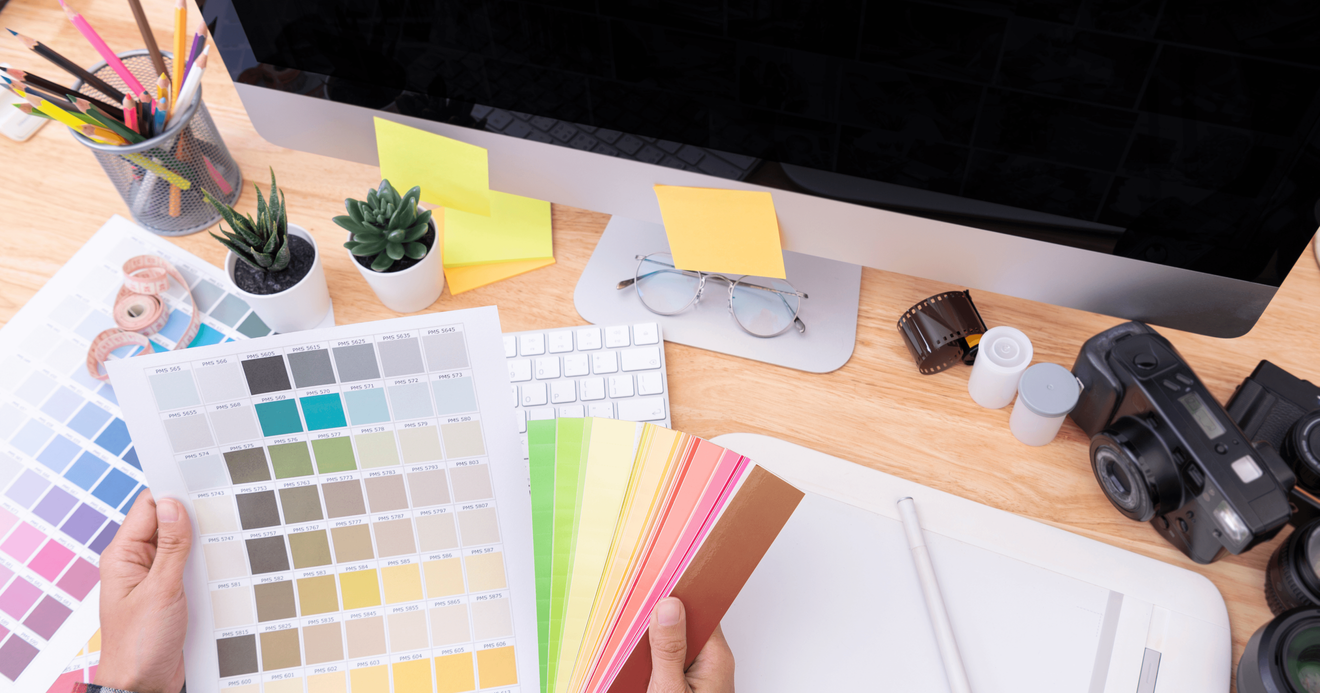Both designers and photographers rely on modeling to interpret reality and convey subjective meaning. Engaging in photography not only develops one’s modeling skills but offers much more.
Author:
Alexander Pryshyvalka | UX Engineer at Coherent Solutions Poland
Consider this wisdom from American photographer Walker Evans: “Stare, pry, listen, eavesdrop. Die knowing something. You are not here long.”
I began my journey in photography during my university years, around 1999. My first camera was a ZENIT, loaded with black & white film. Back then, creating photographs was a hands-on process. I set up a small darkroom in my bathroom, where I was printing photos under the romantic glow of a red light. Sure thing, I fell in love with black & white photography. After some time, I started using a digital camera for increased flexibility. Now, after a several-year break from photography while I focused on extensive growth as a designer, I can finally combine these two passions. Both are significant to me, and I now see how practicing photography can further enhance a designer’s core skills.

Design process
In this text, I’ll discuss two models that help us understand the design process: The Innovation Process as Learning Model and The Analysis-Synthesis Bridge Model.

As The Innovation Process as Learning Model (by Beckman, Barry) suggests: “An ideal learning cycle is one in which the learner goes through all four phases — experiencing, reflecting, thinking, and acting — in a recursive process that is responsive to the learning situation and what is being learned. Immediate or concrete experiences are the basis for observations and reflections [observation to frameworks]. These reflections are assimilated and distilled into abstract concepts from which new implications for action can be drawn [frameworks to imperatives]. These implications can be actively tested and serve as guides in creating new experiences [imperatives to solutions and back to observation]” (Beckman, Barry).
The Analysis-Synthesis Bridge Model which will be described in detail later.

The Analysis-Synthesis Bridge Model (by Dubberly, Evenson, Robinson) is described as follows: “The left column represents analysis (the problem, current situation, research, constituent needs, context). The right column represents synthesis (the solution, preferred future, concept, proposed response, form). The bottom row represents the concrete world we inhabit or could inhabit. The top row represents abstractions, models of what is or what could be, which we imagine and share with others.”
Both models in design are structured as two-by-two matrices. They reveal the fundamental structure and describe the core aspects of the design process, which, in my view, revolves around the interaction between the concrete and the abstract, as well as between analysis and synthesis. In this text, I’ll explore the transition from the concrete “What is” to the abstract “Model of what is.”
Now that we’ve outlined the scope of the design process, it becomes easier to identify the corresponding skills and abilities required of a designer.
Key Designer Skills
Stanford d.school identifies eight essential designer skills. While not all of them are relevant to the subject of this text, there are a few relevant ones that we can highlight:
-
Learn from others (people and contexts). “This means empathizing with and embracing diverse viewpoints , testing new ideas with others, and observing and learning from unfamiliar contexts. Throughout a design project, it’s important to recognize and take the opportunity to learn from others — both end users and other stakeholders and team members. There is a sensitivity to others that develops with this ability.”
-
Move between concrete and abstract. “Everything is connected. When students are building out a new concept — whether a product, service, or experience — they need to be able to nest the concept within the larger ecosystem that relates to it. <…> It involves abstraction to define meaning, goals, and principles, as well as precision to define details and features.”
-
Synthesize information. “…the ability to make sense of information and find insight and opportunity within. This ability requires skills in developing frameworks, maps, and abductive thinking. It takes time and is interdependent with navigating ambiguity.”
-
Design your design work. “This meta ability is about recognizing a project as a design problem and then deciding on the people, tools, techniques, and processes needed to tackle it. It requires using intuition, adapting old tools to new contexts, and developing original techniques to meet the challenge at hand.”
Now that we’ve discussed the first topic in this text, which is design, let’s take a closer look at the second one: photography.

Photography Practice
Photography might seem like a simple act of observing and capturing reality at first glance, but it is true only partially. For me, photography as a practice includes observation, framing, and creating meaning.
In simple terms, photography is firmly rooted in the real world. Even when it takes on abstract forms, photographs are still “made of” tangible, real elements. Whether it’s in the context of photojournalism, street photography, or staged settings, whether it occurs outdoors in natural surroundings or indoors in a studio setting, keen observation is crucial. It requires active engagement, a sharp eye for details, all while maintaining a sense of the bigger picture.
However, despite its connection to reality, photography isn’t entirely objective. As Henri Cartier-Bresson once put it, “Reality offers us such wealth that we must cut some of it out on the spot, simplify. The question is, do we always cut out what we should?” It’s the photographer who frames an image through the viewfinder. Framing means setting subjective boundaries to focus on essential aspects of reality and exclude what doesn’t contribute. This framing reflects a unique, subjective perspective.
In just a split second, a photographer perceives, often intuitively, the connections between elements in a framed picture that may initially appear unrelated. This process involves making sense of reality. To me, this ability represents an insight, defined as “the act or result of apprehending the inner nature of things” (Merriam-Webster Dictionary). This insight essentially pieces together various elements to tell a story.

Overlap between Design and Photography Practices
I’ve noticed a significant overlap between the practices of photography and design, especially during the transition from concrete What is towards abstract Model of what is. This particular phase of the design process can be explained as follows: “Ideally, the design process begins in the lower-left quadrant with observation and investigation — an inventory (or description) of the current situation. As the process moves forward, it moves to the upper-left quadrant. We make sense of research by analysis, filtering data we collect to highlight points we decide are important or using tools we’re comfortable with to sort, prioritize, and order. We frame the current situation, but move out of the strictly concrete. We define the problem. We interpret. A story of what happens suggests a model of what is — an interpretation of our research” (Dubberly, Evenson, Robinson).
During these initial stages, designers gather data about the people who will use a product or service, including their context of use, goals, and needs. The key here is to include as many specific details as possible to firmly ground an idea in reality. Next, it’s crucial to move on to interpreting the research data, a process described as “organizing complexity or finding clarity in chaos” (Kolko). The goal of this step is to create a model of what is, which will serve as the foundation for developing a model of what could potentially be.
Dubberly defines models as “ideas about the world — how it might be organized and how it might work. Models describe relationships: parts that make up wholes; structures that bind them; and how parts behave in relation to one another.” In essence, models are abstractions that reflect one’s understanding of reality.
Models are the outcome of several key processes: observation, framing, and making sense of the world around us. Framing involves viewing a situation from a unique perspective, essentially setting subjective boundaries. This process helps emphasize “a few salient features and relations from what would otherwise be an overwhelmingly complex reality” (Hideaki). Sense-making, on the other hand, entails understanding connections between seemingly unrelated elements. Like framing, it is “highly dependent on unique perspectives and frames” (Kolko). When framing and sense-making work in tandem, they allow us to extract essential aspects of reality and grasp its underlying structure. In essence, they enable us to create a model.
Achieving this insight as a photographer requires more than just having a keen eye. It demands a combination of rational analysis and irrational empathy. As Henri Cartier-Bresson put it, “It is an illusion that photos are made with the camera… they are made with the eye, heart and head.”
Therefore, photography is more than just simple observation. As Dondis pointed out, “Mechanical replication of the environment alone does not make a good visual statement.” In addition to careful observation, what’s crucial is the ability to single out a specific aspect of reality or a particular situation, understand its meaning, and communicate that meaning using the visual language.
Photographs, in a way, can be thought of as models of the world. Both designers and photographers create models to comprehend and visualize a piece of reality or a specific situation. The skills that designers possess, such as learning from others (both people and contexts), shifting between concrete and abstract thinking, and synthesizing information, which I believe are crucial for building models, are also highly valuable for photographers when capturing images.
In summary, both designers and photographers utilize models to express their unique perspectives on reality, ultimately contributing to a deeper understanding of the world around us.
Why is Photography Helpful for Designers?
There are several compelling reasons why photography can be beneficial for developing a designer’s skills:
-
Enhancing Core Designer Abilities: When you practice photography, you’re actually refining three fundamental skills that are crucial for designers. It’s worth noting that there’s a significant overlap between the skills required for both photography and design. This means that while you engage in photography, you can train these essential designer skills:
-
Learning from Others and Environments: By observing people and various contexts, you gain valuable insights that can improve your design work.
-
Transitioning Between Concrete and Abstract Concepts: Photography helps you move seamlessly between concrete, tangible ideas and abstract, conceptual thinking.
-
Synthesizing Information: You learn to gather and combine information effectively, going beyond simple observation to critical thinking and generating fresh knowledge about a subject.
-
Boosting Visual Thinking: While technical proficiency and the quality of the final photo are important, what truly matters is the idea or message you convey through your photographs. As Joel Meyerowitz puts it, “Photography looks like pictures but it’s really ideas, and they’re your ideas.” Engaging in photography trains your ability to develop and communicate ideas visually, in essence, teaching you to think in pictures.
-
Accessibility: Photography is very accessible. At the very least, all you need to get started is a mobile phone with a camera. I firmly believe that outstanding photos, which convey significant ideas, can be captured using any type of camera. This means you can embark on your journey as a designer-photographer with the tools you already have at your disposal.
-
Quantity matters: Just like in anything else, progress in both photography and design relies on consistent practice. However, unlike design, photography offers a more cost-effective and self-directed practice. It costs nothing to step outside and capture a dozen photos a day. Additionally, each photo demands a multitude of thoughtful decisions from its creator. When you combine these factors, it becomes clear that engaging in photography can be an incredibly effective exercise for fostering personal creativity.
-
Photography as a Project Activity: Photography isn’t limited to standalone shots; it can also be approached as a project or a series of photos, enabling the communication of more complex messages. Within a project, images are no longer isolated; instead, they form connections and influence one another. To create a project successfully, a photographer needs to organize their work. A project involves several backstage tasks, including:
-
Research: Gathering information about the subject.
-
Exploration: Examining the subject from various angles, delving deeper, and ultimately gaining a profound understanding.
-
Idea Specification: Clearly defining the idea to be developed.
-
Approach Selection: Deciding on the method to bring the idea to life.
-
Planning: Creating a detailed plan and translating the idea into a tangible form.
In this way, photography as a project activity not only sharpens your photography skills but also fosters another crucial designer’s ability—designing your own design work (as mentioned earlier).
Conclusion
Photography is a powerful way to develop four important skills for designers, as suggested by the d.school:
-
Learning from Others (People and Contexts)
-
Transitioning Between Concrete and Abstract Concepts
-
Synthesizing Information
-
Designing Your Own Design Work
In addition to these core skills, photography provides opportunities to cultivate other valuable traits. For example, it helps you elaborate on ideas and convey them through visual language, thereby enhancing your visual thinking. Furthermore, photography aids in the visualization and understanding of your own ideas and values.
In a nutshell, photography offers a way to unravel the complexities of the world around you and find answers to personal questions.
Read also: How Playing Improvised Music Can Train The Ability To Synthesize In Design



